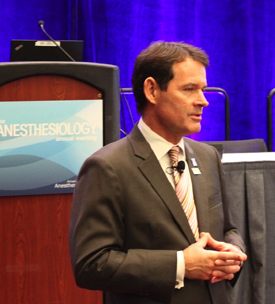
2016-17 ASA President Jeffrey Plagenhoef, M.D., FASA
During the question-and-answer portion of Monday’s “Strategic Dialogue on the Future of Anesthesiology” session, former ASA Vice President for Scientific Affairs Arnold J. Berry, M.D., M.P.H., began his comments by paraphrasing Ronald Reagan: “Status quo is Latin for ‘what got us into this mess.’”
Dr. Berry was one of several audience members who addressed session leader Jeffrey Plagenhoef, M.D., FASA, in front of a full house of participants who came to discuss how to create the best possible future for anesthesiology. All seemed to agree that the specialty — and medicine in general — is at a transformative moment in its history.
The primary goal of the session was to gather issues and concepts to be considered at the ASA “Strategic Dialogue Summit” planned for January 19-20, 2018. Roughly 50 thought-leaders from within and outside the specialty have been chosen to participate in the summit.
“We want to include everyone in this discussion who cares about the future of our specialty,” Dr. Plagenhoef said. “The purpose of this summit is to create unity within the anesthesia community so that 15 or 20 years down the road we’re doing an even better job of taking care of the patients we serve.”

Dr. Plagenhoef answers questions from the audience Monday.
During the Monday morning session, Dr. Plagenhoef reiterated overarching themes that defined his term as president in 2017, particularly advocacy and personal involvement. Even if you’re a “top 10 percent” clinician and you save everyone’s life in the O.R., he said, you “haven’t done a thing to address the top eight to 10 issues that — if we don’t win in our state capitals and the nation’s capital — the right story won’t be told about what we do.”
When asked about recent coordinated attempts by non-physician groups to expand their scope of practice, Dr. Plagenhoef stressed the urgency of physician anesthesiologists to “show up.” Last year’s VA Nursing Handbook victory, in which independent practice for nurse anesthetists was carved out of the handbook, occurred because physician anesthesiologists took the initiative to change the narrative of the debate to facts that support physician-led, team-based anesthesia care for our nation’s veterans.
“We made it clear to all stakeholders that there is a difference between nurses practicing independent of physicians in outpatient primary care clinics and nurses working without physician oversight in emergency departments, intensive care units and surgical operating rooms where the threats to patients’ health and life can be magnitudes greater,” Dr. Plagenhoef said.
Though advocacy was often front and center in the conversation, audience members addressed several themes they viewed as essential for the specialty’s growth.
One audience member talked of the need for an “all hands on deck” effort to “get serious” about genomics and personalized perioperative medicine programs that would respond to how a patient’s genetic and epigenetic profiles interact with anesthesia and surgery. These efforts, he said, will help anesthesiology transform itself in the way cardiology, neurology and medical imaging have recently done.
The expanding role of telemedicine was explored, with a general consensus that such technology will increasingly augment anesthesia delivery while saving money and improving care.
Dr. Plagenhoef also addressed the importance of incorporating nonclinical education topics — practice management, advocacy, professional citizenship, etc. — into all anesthesiology residents’ education. ASA is leading efforts in this area and has recently formed an Ad Hoc Committee on Essential Resident Education.
As varied as the ideas were about how best to advance the specialty, the theme of personal responsibility was the single thread that tied the discussion together.
“It really bothers me when people criticize the ASA for not doing this or not doing that,” Dr. Plagenhoef said. “But ASA is just a bunch of anesthesiologists. We invite everybody to take part in the discussions. Any failure for us to do what you want done individually is your fault for not showing up and sharing. You have to show up.”
More information on the January 2018 “Strategic Dialogue Summit” will be made available to ASA members in the coming months. In the meantime, Dr. Plagenhoef welcomes comments and suggestions from any ASA member about how to create the best possible future for the specialty.
He can be reached at j.plagenhoef@asahq.org.
Return to Archive Index